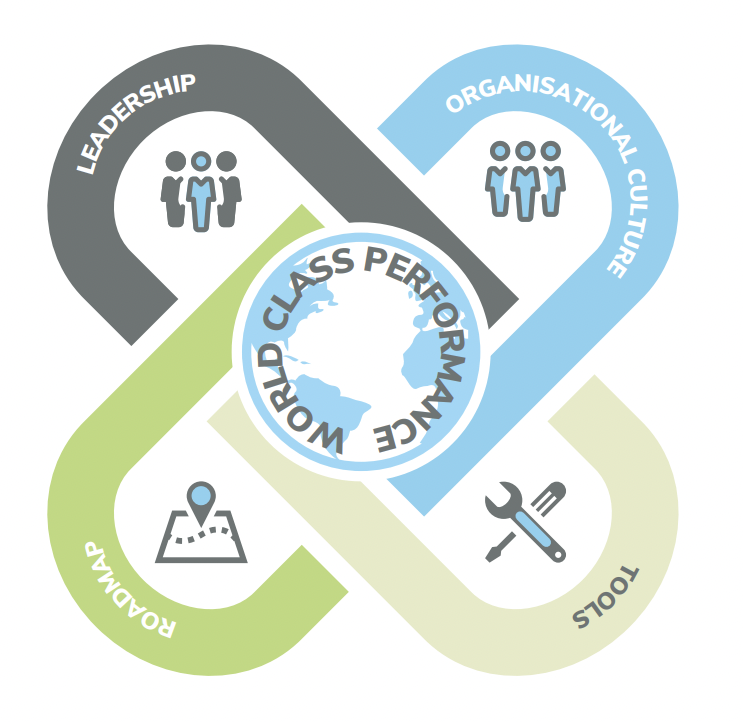Continuous Improvement Methodologies
Everything You Need To Know
The business world is becoming increasingly competitive, driving organisations to adopt various strategies at once to keep market share and prosper in their industries. It involves everything, from strengthening the organisational structures and team behaviours to improving productivity by choosing a sustainable mix of continuous improvement methodologies.
The most successful companies utilise several such philosophies to maintain their rightful place on the top. From all, Continuous Improvement (CI) is characterised as the main element of unifying such strategies under one programme and achieving competitive excellence in today’s market.
This page will provide a rapid overview of the primary Continuous Improvement methodologies and the principles behind them. It can help improve existing programmes or lay the foundation for a new successful Continuous Improvement framework in every organisation.
In this article, we’ll cover:
"Buzzword"
Continuous Improvement (CI) is a buzzword everyone knows, but only a few fully understand. Defined as the method organisations use to accomplish their goals for tremendous success and growth (CI) also allows businesses to streamline their organisational processes and minimise inefficiencies.
What is Continuous Improvement?
The roots of modern improvement programs can be traced back to initiatives undertaken in several companies in the 1800s, where management encouraged employee-driven improvements, and incentive programs were set in place to reward employees that brought about positive changes in the organization.
By the 1950s, Continuous improvement methodologies became popular worldwide. Adopting these methodologies promised lower operating costs, improved employee morale, greater customer satisfaction, and greater overall organisational success.
Is it one-size-fits-all approach
CI is a company-wide process designed to drive more successful results for an organisation. It can involve several methodologies or continuous improvement techniques, working in unison to improve efficiencies and reduce waste. Each company can have a unique approach to achieving CI based on its internal resources and capabilities. However, despite the mix of tools a company decides to use, the final goal is always the same: To define a clear path for incremental changes that consistently improve organisational processes.
6 Continuous Improvement methodologies & Tools
Each company can have a unique approach to achieving CI. However, all continuous improvement techniques have the same goal: To define a clear path for incremental changes that consistently improve organisational processes.
1: Lean Manufacturing
Lean manufacturing is a CI methodology that eliminates waste in all production areas, from customer relations to product design, supplier networks, and factory management. It follows a few key principles to achieve this goal, including:

Waste refers to organisational activities using resources without producing real value in return. Eliminating any waste in organisations can help your business achieve greater outcomes with improved efficiencies, allowing your company to operate in a ‘lean’ and more efficient way.
2: Total Productive Maintenance
TPM, or total productive maintenance, is a CI methodology focusing primarily on the people and equipment to achieve a perfect production process. The following are eight pillars that make an effective Total Productive Maintenance model:

Two primary aspects of TPM include being proactive and using preventive maintenance to prevent maintenance issues, and that everyone involved should hold a degree of accountability for maintenance.

Shared ownership, from top management to technicians on the floor, for all maintenance requirements bolsters a proactive approach to achieving continuous improvement.
Later reads:
3: Six Sigma
A set of data-driven quality control techniques
Six Sigma is a continuous improvement technique that focuses on mitigating process variation and improving control by offering organisations the tools necessary to improve their business processes. This CI method allows organisations to improve its performance and reduce process variations by using the following tools:

These are all different tools but share similar characteristics. These Sigma Six tools boost profitability, improve employee morale, and enhance an organisation’s product and service quality.
4: World Class Manufacturing
WCM, or World Class Management, is a continuous improvement technique developed in 2005. It is a structured and integrated production system spanning all organisational processes involving everyone, from top management and staff on the production floor. This CI methodology is well-established as a CI programme in its own right, but it borrows from several other methodologies.
It has 20 principles split across two categories:

WCM is relatively new among continuous improvement methodologies, and it is often regarded as the most complete CI approach right now.
5: Value Stream Mapping
VSM, or Value Stream Mapping, is a continuous improvement technique used in Lean manufacturing to improve organisational efficiencies by eliminating activities that don’t add value or produce waste by enhancing information exchange processes and physical movement operations. Value Stream Mapping covers value-adding and non-value-adding activities through an end-to-end analysis. It lets you identify waste to understand how to eliminate it, giving you the bigger picture to make more impactful changes, either in specific organisational processes, or holistically throughout the company.
The VSM process lets you visualise all the steps of your organisation’s work processes. It displays the important steps in your work process necessary to deliver value from start to finish. VSM lets you visualise each task your team works on, providing you with singleglance status reports of each assignment’s progress.

Value Stream Mapping covers value-adding and non-value-adding activities through an end-to-end analysis. It lets you identify waste to understand how to eliminate it, giving you the bigger picture to make more impactful changes, either in specific organisational processes, or holistically throughout the company.
6: Kaizen
Kaizen is a CI technique named after the Japanese term that means Good Change. The Kaizen core philosophy is that consistent and small positive changes can help organisations experience substantial improvements in productivity and efficiency. Toyota, the Japanese car manufacturer, defines its approach to doing business using Kaizen.
This CI technique emphasises continually embracing change and learning while respecting coworkers, providing job security to employees, and motivating people to engage each team member by encouraging active participation.Businesses generally need continuous improvements to meet and exceed customer expectations. Kaizen deploys statistical tools and incorporates business values to enact those changes.
However
One disadvantage of Kaizen is the challenge of implementing change itself. Without a holistic approach where everyone in the company is on board to work toward CI through Kaizen, it can make it difficult for businesses to change the systems they are used to. We have attached one of our articles offering nine ways of minimising resistance to change in any organisation.
What Are the principles of Continuous Improvement ?
The continuous improvement model reflects the idea that organisations must implement incremental improvements to their services, products, and processes. Regardless of a business’s preferred CI methodology, a few central principles should guide its approach to CI. This section of the article will give you a brief overview of the essential principles of continuous improvement:
IMPROVEMENTS ARE BASED ON INCREMENTAL CHANGES RATHER THAN MAJOR PARADIGM SHIFTS
Sudden and significant changes risk destabilising organisations by disrupting their processes. Approaching CI with small and incremental changes helps maintain disruptions, allowing a speedier adoption of changes.
Every idea with the potential to increase efficiencies, help employees develop new skills, or eliminate defects is worth exploring.
EMPLOYEE INPUT IS INVALUABLE
CI models do not rely solely on an organisation’s leadership team. Its employees are also critical in identifying improvement opportunities. Employees are closer to the company’s problems, making them better equipped to identify and address challenges. Engaging your staff can go a long way in helping you achieve organisational goals.
IMPLEMENTING INCREMENTAL IMPROVEMENTS IS TYPICALLY INEXPENSIVE
Employees tend to suggest smaller changes that organisations can implement at lower costs. Typically, employee ideas involve improving efficiencies by eliminating unnecessary steps, ensuring that every activity reduces wasted effort and adds value to the business.
ENGAGING EMPLOYEES ENCOURAGES OWNERSHIP AND GREATER INVOLVEMENT IN IMPROVEMENTS
Implementing organisational changes is challenging. However, a key to encouraging positive change is to derive changes from the frontline rather than top-down implementation. When you encourage staff to develop ideas to improve their work, they are likelier to feel more inclined to understand the importance of the changes. Since the CI model relies on employees for organisational improvement, your staff might be more invested in the outcome of the changes. Fostering such an environment has a better chance of creating sustainably successful improvements with minimal resistance to change.
IMPROVEMENT REQUIRES FEEDBACK
Open communication while executing each improvement idea and constant feedback are critical to engaging employees and getting final results from the changes. People in leadership positions must prioritise improving communication lines to deliver necessary feedback on changes as they happen. Constant feedback allows staff to get help when they need it from their managers and keeps everyone on the same page.
MEASURING IMPROVEMENTS IS CRITICAL
Simply making a change does not warrant calling it an improvement. Achieving real success requires understanding how to measure the impact of changes. Knowing how a change impacts the organisational processes can help determine whether the changes apply to other problems. You can measure improvements through several key performance indicators specific to your organisation, including cost savings, revenue increase, customer satisfaction, reduction in defects, and more.
Businesses can adopt several possible continuous improvement methodologies to achieve organisational success and growth goals. Each has its merits and drawbacks, but keeping a few core principles as the background context will make the real difference in how impactful they can be for your business.
The Henkan Way
For Continuous Improvement Methodology
The Henkan Way is a proprietary CI methodology that embodies the principles of continuous improvement and applies an intelligent blend of different methodologies tailored to each organisation’s unique needs. Aligning with the core principles, the Henkan Way is a people oriented approach underpinned by independent elements. It brings you the best features from different CI techniques for a truly tailored approach to improving your business processes.
The 4 Key Components
This approach has a few interdependent elements that are key to creating and fostering an organisational culture that is geared toward sustaining a continuously improving environment:
Adopting a holistic approach to continuous improvement is conducive to growth and success. CI programmes are deeply rooted in traditional manufacturing-centric systems, concentrating on improving production lines to eliminate waste, enhance quality, and increase efficiency.

The Benefits of Continuous Improvement
Empowered Employees
Developing employee accountability gives them the confidence and drive to make positive changes autonomously.
Seamless Processes
Identifying the root cause(s) of inefficiency enables you to improve current organisational processes by eliminating waste and driving a team of autonomous problem solvers.
Increased Staff Retention
Crafting a culture of appreciation and a sense of purpose will reduce turnover rates, boost engagement and increase the likelihood of employees feeling valued and empowered, maximising retention.
Competitive Advantage
When your processes are running efficiently and your employees are feeling content, you are able to enhance the value and output of your products.
Long-Term Growth
By continuously ensuring leadership buy-in, employee engagement, and seamless processes, you are setting up your business for sustainability and long-term success.
A Cohesive Bond
CI encourages company-wide communication; working together as a team to achieve one common goal. This connects people and offers a shared sense of community wherein people are enthusiastic about helping and supporting each other in all organisational processes.
Creating a Culture of Continuous Improvement
Acknowledging the fact that there are inefficiencies in your organisation and identifying the importance of accepting and implementing changes is the key to beginning continuous improvement. The CI models discussed above are excellent examples of powerful continuous improvement methodologies that can foster evolution to sustain consistent success for any organisation.
Implementing CI
Implementing CI models can be overwhelming, especially when you are unsure about how to begin, whether you are on the right path, or if you do not have enough experienced and competent resources available at your organisation. If you are a business owner struggling with the notion of implementing a CI model due to similar challenges, you can count on us for help.
Our Experts
We handpick our consultants specifically because they can engage people and organisations in successfully delivering CI programmes suited to their goals. Count on us to take on the responsibility of guiding you on your journey and empower you to become experts to continue growing a culture of continuous improvement in your organisation and unlock your true potential.
Ready to progress ?
Maximise your internal effectiveness by investing in your resource capabilities and waste management. Turn your weaknesses into a competitive advantage.








